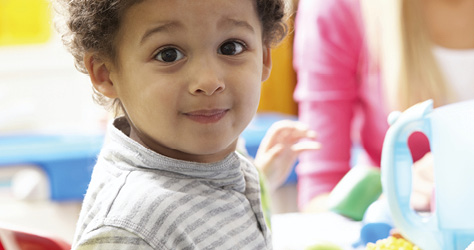As they grow up fast, here's what to expect as your three year old develops
Pre-schoolers are all individuals and although we can encourage them, they will do things at their own pace and in their own time. Here's what to expect in the coming six months.
At a glance
- Making friends
- Learning the alphabet
- Tricks and skills

Hopping and balancing
Your toddling toddler has definitely gone, and replaced by an altogether more physically confident model. Many three-year-olds will be able to catch a bounced ball (sometimes), pedal a tricycle - with mixed results on the steering front for up to another year - and love clambering over really quite adventurous play equipment in the park. They may also be able to hop on one foot now and balance for a couple of seconds, although some pre-schoolers won’t manage that until nearer four.
Friends at last
After an entire lifetime spent ignoring their baby friends or at best playing alongside them while doing their own thing, at last – your three-year-old is actually playing with friends and interacting directly with them. It’s a great moment as they begin to work out how to play co-operatively, learn how sharing toys can be a positive thing (maybe) and try to work out what makes their little friends tick. It’s very normal at this age to have an imaginary friend, though not all children do. After all, they need someone to take the flak when things go wrong...
ABC
If your little one is interested, it’s fun to teach them the ABC song and to point out words on a page or a road sign. Some three-year-olds will recognise their own name from the shape of the letters, but don’t push it if they’re not interested. There’s plenty of time for this later. At this stage it’s most important to show them how much fun reading, rhymes and books are – that’s the best grounding for the ‘official’ learning of phonics, which comes later, at around four. Singing nursery rhymes is the best way to let them hear the sounds in words, which is an important part of learning to read later on. Keep it fun for now.
New tricks
Your little one might be just about undressing themselves now (hopefully at a time of your choosing) though dressing takes a little longer, probably another six months to a year. They may be able to put on their own hat and coat now, though not zip it up for a while longer. It’s a good idea to give them a bit of time to work it out before you step in and rescue them. Or start the zip and let them finish pulling it up. Your pre-schooler’s teacher will thank you for this in a few months’ time...
How to help
- Explaining why you have certain rules, like holding hands to cross the road, may encourage him to follow them. Praise them when they do it right.
- Their spatial awareness is coming on well now – it’s a good time for a ride-on toy if your skirting boards can stand the pain.
- Hopscotch is a great way to teach balance and co-ordination.
- Join playgroups to encourage their emerging social skills.
- Their speech is really coming on now and they may be able to tell you their full name and age.
- If their speech is still very unclear to everyone but you, it’s worth getting some advice from the health visitor or speech therapist.
- Family meals are a great habit to get into so they can practise table manners, as well as listening and talking. Realistically, few parents can do this every day, but once or twice a week is still great.
- Around now you may start getting your first basic drawings of people as they can draw circles by around three. Massive praise is due.
Read more about pre-school development anxiety and see our milestones guide here.